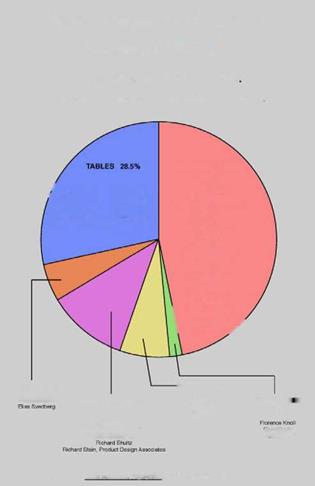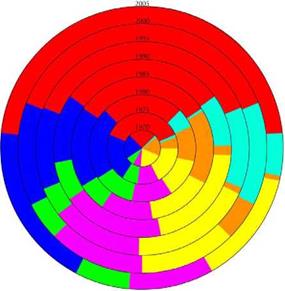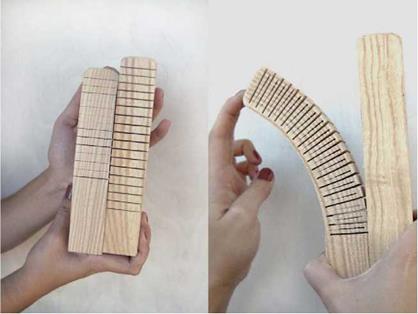A chart, two – or four-axis model, or matrix can indicate quantitative and qualitative relationships within a general or specific framework. An example of a two – or four-axis model might indicate the number and concentration of expensive/inexpensive furniture pieces relative to a cross-axis indicating volume of sales or some other quantitative measure (see Figures 1.21, 1.22, and 1.23).
Furniture design research is often applied, realized through design and fabrication venues. Designers utilize human factors research and anthropometric data in the design of chairs. This engages a scientific method working from assumed principles within the constraints of quantitative data (Figure 1.23). Designers also explore and experiment with

 from approx. 1941-1960
from approx. 1941-1960
 seen as a percentage or the total number ot pieces from 1941-1960
seen as a percentage or the total number ot pieces from 1941-1960
CHAIRS/SEATING
46.8%
![]()
![]()
 |
|
Franco Albini Harry Benoia
 |
 |
Bonet. Kurchan and Hardoy Lewis Butler Andre Dupre Joseph Frank Pierre Jeanneret Henry Kann Florence Knoll Donald Know George Nakashima Isamu Noguchi Kurt Nordstrom Odelberg Olson Ralph Rap son Jens Risom Eero Saarinen Abel Sorenson 1 Elias Svedberg liman Taprovaara Mies van der Rohe / Unknown /
Armrest Height No Armrest
 |
||
Backrest Angle 20 Degrees applies to ail percentiles
materials and fabrication techniques rather inductively. Through the process of experimenting with materials and methods of fabrication, designers can discover fascinating applications and opportunities for utilizing materials to achieve innovative performance in design (Figure 1-24).
Mapping information can indicate relationships between fixed and variable conditions and help to visualize data within the constraint of an established framework such as time, place, or cost.
Lexicons
A lexicon is a collection of words or terms that relate to a branch of knowledge, discipline, or part of a specific population or subset. The discipline of furniture design includes a broad collection of subheadings, ranging from:
■ Technical (i. e., jointer, rabbet joint, PVA glue, closed cell, roto-mold)
■ Descriptive (i. e., luster, knock-down, symmetrical)
■ Process focused (i. e., sketching, injection mold, digital fabrication)
■ Social use (i. e., hospitality, office, residential)
■ Theoretical (i. e., ergonomic, lumbar lordosis, haptic sensation)
Historical (i. e., cathedra, credenza, ebeniste, modern)
A broad lexicon of terms exists within each of the distinct categories outlined in the preceding list. Furniture styles are generally broken down by periods such as Queen Anne, Georgian, Modern, and Post-Modern. Most furnishings are described by their social use (i. e., residential furniture, outdoor furniture, nursery furniture, office furniture, etc.). Designers utilize an exclusive vocabulary of terms (aka design-speak), which include parti, iteration, enfilade, unity, and dichotomy. Historians understand words like cathedra, voyeuse, and coffer.
A lexicon can be organized or visualized in a number of ways. Terms can be grouped, listed alphabetically, defined, mapped, analyzed, and used in context. Lexicons are useful in organizing the parameters for pointed, focused, design inquiry.
The lexicon shown in Figure 1.25 delineates synthetic intersections of social use and formal composition. The lexicon is an attempt to organize furniture pieces into discrete components, which include physical, spatial, and functional headings. The organization of a lexicon is generally less important than the process and discoveries that transpire
 Figure 1.24 Success in experimenting with an innovative technique of cutting wood in order to achieve a resilient, spring-like quality in the wood. Photography and design by Mary Dickerson, (2011).
Figure 1.24 Success in experimenting with an innovative technique of cutting wood in order to achieve a resilient, spring-like quality in the wood. Photography and design by Mary Dickerson, (2011).
through its conception, development, and resolution. As an exercise, consider completing the lexicon or determine other organizational approaches that establish boundaries and constraints to categories and typologies of furniture.
The primary goal for many furniture designers is to create designs that improve upon existing products or to provide entirely new designs that deliver new ways to work, rest, or play. In doing either, designers broaden the world through fresh and personal points of view.
As a tangible reality, furniture is composed of materials and finishes, held together by engineered joinery, and experienced physically and spatially. Furniture is also composed of intangible aspects that reveal ideas about comfort, ergonomics, proxemics, cultural meaning, social status, use, spatial organization, and aesthetics. These intangible aspects serve as a basis for theory. Not all dimensions are measurable, and neither are details limited to physical characteristics. It is imperative to consider tangible and intangible aspects concurrently when designing and making furniture.
Before we delve into the intangible aspects of theory, let’s first consider the broader taxonomy of function and social use categories within a cultural and societal framework, followed by the more descriptive and measurable characteristics of built-form.
ENDNOTES
1. The terms movable and equipment are used to describe furniture in the following sources: Webster’s Illustrated Contemporary Dictionary (Encyclopedic edition, J. G. Ferguson Publishing Company, Chicago, 1988); The American Heritage Dictionary of the English Language, 4th edition (Boston, MA: Houghton Mifflin Company); The Compact Oxford English Dictionary, revised edition (Oxford: Oxford University Press, 2003); and www. dictionary. com.
2. The Compact Oxford English Dictionary, revised edition (Oxford: Oxford University Press, 2003).
3. The organization of furniture using typological categories is a common approach. Edward Lucie – Smith, in Furniture: A Concise History (London: Thames and Hudson, 1993), outlines four headings, "the first of which responds to the idea of function stating one can sit on a piece of furniture (stools, benches, and chairs); or else one puts things on it (tables and stands); sleeps or reclines on it (beds and couches); or uses it for storage (chests and wardrobes)" (p. 8).
4. The Compact Oxford English Dictionary.
5. Structured play is a phrase that faculty have used to describe the activity of design in the First Year Design Studio in the School of Architecture and Interior Design, College of DAAP at the University of Cincinnati.
6. The Compact Oxford English Dictionary.
![]()
chapter



